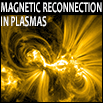Speaker
Elin Eriksson
(Swedish Institute of Space Physics, Uppsala, Sweden and Uppsala University, Department of Physics and Astronomy, Uppsala, Sweden)
Description
Regions with vanishing magnetic field, also referred to as
magnetic nulls, are of high
interest in plasma physics. Near magnetic nulls particles
become unmagnetized and
can by interacting with electric fields be accelerated up to
high energies. Magnetic
nulls have been observed and studied before using in-situ
observations for selected
events. Here we present the first statistical study of magnetic
nulls in the Earth's
nightside magnetosphere. In addition we study how local
disturbances in the magnetic
field can affect the null type identification and we present a
method to estimate the
reliability of the null type identification.
We study the magnetic nulls using full resolution data from
the Cluster spacecraft
when their maximum separation are less than one ion inertial
length. This is fulfilled in
2003 when the spacecraft separation was approximately 200
km. The magnetic nulls
are found using two methods: Poincaré index and Taylor
Expansion. The use of Taylor
Expansion allows us to find nulls outside the spacecraft
tetrahedron volume. All
together 25 time intervals containing magnetic nulls are
found. We find most of the
nulls in the magnetopause current sheet, but a few of them
are found in the tail
current sheet. We find the currents associated with each null
and classify the types of
the nulls. We present a detailed analysis of two typical
examples of the observed
nulls. The first one is from August 6, 2003 00:45:40.02 -
00:45:41.02 UT and the
second is from October 28, 2003 04:16:01.0 - 04:16:02.0
UT. In both examples the
spacecraft are in the magnetotail and observe magnetic nulls
crossing the volume
surrounding the spacecraft. In one of the events the type of
the magnetic null is
changed for a short moment during the crossing. We
interpret this jump as being due
to local disturbances in the magnetic field. We present a
general method of how to
estimate the effect local disturbances have on the null type
identification. The
obtained results are highly relevant for MMS studies of
reconnection diffusion regions.
Primary author
Elin Eriksson
(Swedish Institute of Space Physics, Uppsala, Sweden and Uppsala University, Department of Physics and Astronomy, Uppsala, Sweden)
Co-authors
Andris Vaivads
(Swedish Institute of Space Physics, Uppsala, Sweden)
Mats André
(Swedish Institute of Space Physics, Uppsala, Sweden)
Volodymyr Khotyayintsev
(Department of Theoretical Physics, Taras Shevchenko National University of Kyiv, Ukraine)
Yuri Khotyaintsev
(Swedish Institute of Space Physics, Uppsala, Sweden)

